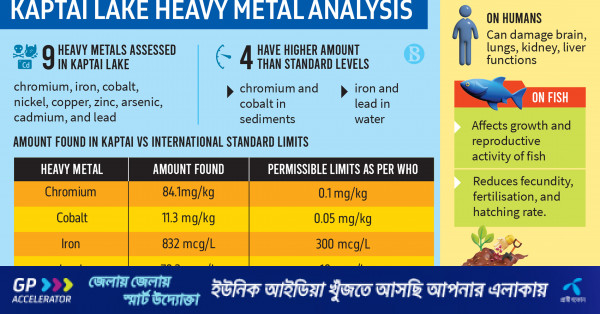Excessive heavy metals in Kaptai Lake: Researchers


A recent research conducted on Rangamati’s Kaptai Lake has found that concentrations of different heavy metals in both sediments and the lake’s waters exceed international safety standards, raising concerns among stakeholders and health experts about the associated environmental and health risks such as damage to functioning of brain and lungs.
Some of the metals were found to be more than 500 times of the standard value and the study attributed the staggering numbers to human-induced environmental pollution such as waste dumping and use of pesticides in surrounding areas.
The study, published in the international journal Applied Radiation and Isotopes, analysed 32 sediment samples and 10 water samples from different locations of the lake to determine the presence of nine heavy metals – chromium, iron, cobalt, nickel, copper, zinc, arsenic, cadmium, and lead.
According to the study, average concentrations of Chromium and Cobalt in the lake’s sediments, as well as iron and lead in its water, were found to surpass the guideline values set by the World Health Organization (WHO) and the United States Environmental Protection Agency (USEPA).
In sediments, chromium levels were at 84.1 mg/kg, which was significantly higher than the WHO and USEPA standard of 0.1 mg/kg and 25.0 mg/kg, respectively. Cobalt levels were found to be 11.3 mg/kg, exceeding the WHO guideline of 0.05 mg/kg.
As it is almost impossible to remove metals from the polluted water and sediments of the lake, necessary precautions based on the data on metal pollution levels are crucial for implementing effective pollution control measures.
Dr Mohammad Amirul Islam, chief scientific officer at the Institute of Nuclear Science and Technology
Moreover, different environmental pollution indexes indicated minor enrichment of arsenic and zinc in the sediments of Kaptai Lake.
In the water, the study found that iron concentrations were 832 mcg/L, which was far above the WHO standard of 300 mcg/L, and lead levels were 70.2 mcg/L, surpassing both the WHO standard of 10 mcg/L and the USEPA standard of 2.5 mcg/L.
The concentrations were determined after examining their distribution and contamination in the lake by neutron activation analysis and atomic absorption spectrometry techniques, the study explained. The overall concentrations of heavy metals in the sediments of the lake are comparable to many lakes and reservoirs all over the world except the lakes affected by anthropogenic sources, it added.
Moreover, for residential receptors exposed to the heavy metals in lake water, the study found that there is no carcinogenic risk for arsenic while chromium showed a slight carcinogenic risk.
The research titled “Heavy Metal Analysis of Water and Sediments of the Kaptai Lake in Bangladesh: Contamination and Concomitant Health Risk Assessment” was carried out by a team of five researchers.
Two of the researchers – Biplob Das and Mohammad Belal Hossen – were from the Department of Physics at Chittagong University of Engineering & Technology.
The other three – Mohammad Amirul Islam, Umma Tamim, and Farah Tasneem Ahmed – were from the Institute of Nuclear Science and Technology under Atomic Energy Research Establishment of Bangladesh Atomic Energy Commission.
Talking to The Business Standard, the researchers said their aim was to assess the distribution of heavy metals in the surface sediments and water of Kaptai Lake, investigate the ecological risk, find out the degree of metal contamination, and identify the sources.
Any agricultural activity relying on the lake’s water poses a significant threat to human health. Lead, in particular, can pass through the blood-brain barrier and cause neurological problems.
Dr Tajuddin Sikder, professor at Department of Public Health and Informatics, JU
They said the results of the study will help in developing a pollution control strategy for the lake.
Dr Mohammad Amirul Islam, one of the researchers and also the chief scientific officer at the Institute of Nuclear Science and Technology, said, “As it is almost impossible to remove metals from the polluted water and sediments of the lake, necessary precautions based on the data on metal pollution levels are crucial for implementing effective pollution control measures.”
Apart from being a scenic water body, Kaptai Lake is a source of income for many residents of Rangamati’s Kaptai upazila through fish farming, river communication, irrigation, and tourism.
The lake was primarily built for hydroelectric power generation, by damming the Karnaphuli River close to the Chittagong Hill Tracts.
However, the paper mentioned that environmental contamination from waste dumping, open defecation, fertiliser and pesticide use around the lake, and discharge of oily chemicals from boats are some of the major sources of pollution at Kaptai Lake.
Heavy metal toxicity can damage the functioning of the brain, lungs, kidney, liver, blood composition and other important organs in humans, according to the USA’s National Institutes of Health (NIH). In fishes, it affects their growth and reproductive activity, also reducing fecundity, fertilisation, and hatching rate. In agriculture, heavy metals decrease soil fertility and crop quality.
The situation is, however, not unique to Bangladesh’s Kaptai. Many lakes around the world are affected by heavy metal pollution due to various factors.
Lakes like Dal, Kolleru and Lonar in neighbouring India were also affected by heavy metal pollution, according to a study published in Nature Environment and Pollution Technology journal. In Pakistan, its Naltar lakes were also contaminated with heavy metals, an article published on USA’s National Library of Medicine said.
Dr Tajuddin Sikder, a professor at Jahangirnagar University’s Department of Public Health and Informatics, expressed concern over the high levels of chromium and lead in the lake.
He said, “Any agricultural activity relying on the lake’s water poses a significant threat to human health. Lead, in particular, can pass through the blood-brain barrier and cause neurological problems.
“Therefore, it is imperative for authorities to determine whether agricultural and food processing systems around Kaptai Lake have infiltrated the local food chain,” he further said, adding “vegetables can absorb heavy metals through a process called bioaccumulation.”
He emphasised that the relevant authority needs to review the study’s findings again and promptly implement effective measures.
Md Fardoush Anwar, deputy director of the Department of Environment (Chattogram), also in-charge of Rangamati’s environmental affairs, told TBS, “The research findings are alarming. If the findings turn out to be true, we will take swift action. However, we will first review the study again.”
“There are poultry farms, ice factories, and some sawmills near the lake. Besides these, the factors mentioned in the research are responsible for the contamination,” he added.
He further said, “While we do not conduct heavy metal tests, we will assess the water quality of Kaptai Lake. This is crucial because if fish from the lake enter the local food chain, it could have severe consequences.”




